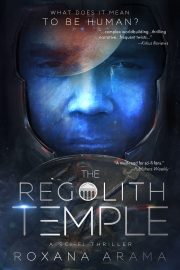The Poet’s Toolbox: Three Strategies for a Vivid Prose Voice
By Ursula Whitcher
Writing poetry allows for rapid experimentation with language on a fine scale. Though there’s lots of mystique around being a poet, the key genre expectation is close attention: poetry rewards readers for noticing what’s happening at the level of a page, a phrase, or even a pair of words. But poets don’t have a monopoly on evocative language! Let’s explore three ways that fiction writers can turn poetic techniques to their own ends.
Line length matters
A poet developing a poem will experiment with pauses: should lines sprawl across the page in Whitman-esque fashion, or scroll rapidly, a few words at a time? Prose, on the other hand, sets up rhythm at the sentence and paragraph level.
You probably have a sense of your own rhythmic habits. Maybe you’ve never met a semicolon—or an em-dash—that you couldn’t love. Maybe you like brief sentences. And sentence fragments. Perhaps you monitor your excesses in revision, breaking long sentences or joining short ones.
Habit isn’t destiny. You can choose a different rhythm to evoke a particular voice, mood, or character. Arkady Martine’s short story “Three Faces of a Beheading” uses both formal and informal narration styles. The informal narrator flips between breathless run-on sentences and rapid fragments. A one-sentence paragraph begins “Your local chat goes predictably berserk…” and finally ends “…enjoy your chat with the nearest representative of the state police see you never.” In the next section, the narrator says:
“Okay.”
“Okay okay okay, let me explain.”
You can hear the narrator trying to take deep breaths. Each of these paragraph breaks signals a tiny shift in mood, the way a poet might.
Words are delicious
Poets are reliably fascinated to hear I’m a mathematician. This isn’t because they secretly wish they’d taken more calculus (at least most of the time!). It’s because poets are fascinated by new words and styles of writing. They rightly suspect that research mathematics involves a glittering collection of weird new vocabulary.
Some prose word-collectors revel in contrast. For example, Yoon Ha Lee’s story “The Ethnomusicology of the Last Dreadnought” contains the line “Consequential engagements were carried out allegro con fuoco, with engine-room energy outputs in excess of 250 kilophoenixes.” The sentence is framed as dry military description, but “allegro con fuoco” is a musical composer’s direction. “Kilophoenixes” is an invented compound, fusing a technical prefix and a fantastical image to create an impression of terrifying power.
Assembling words with similar flavors can evoke the mood of a particular type of prose. Pushed to its extreme, this kind of collection can become a deliberate invocation of someone else’s style—in other words, pastiche. Ann Leckie’s first published story “Hesperia and Glory,” references early twentieth-century adventure stories, particularly Edgar Rice Burroughs’ Martian tales. The story’s narrator is a meticulous observer but emotionally distant. Here he is describing a strange houseguest, for instance: “His suit was gray with dust and his collar wilted and dirty. As I shook his hand I could not help but notice his listless grip and petulant expression.” The physical detail (gray, dust, wilted, dirty) uses short, forceful words whose roots go back to Old English (or, in the case of “dirty,” Old Norse). Though he tries to sound impartial, the narrator’s description of his guest’s mental state is full of his own emotional responses; as minor as these feelings are, he camouflages them with intellectualizing Latin roots like “petulant.”
What’s going on with that petulant guest? The revelation leads us to our third poetic technique.
Metaphor is character
It can be easy to focus on metaphor and similes as tools for communicating sensory experience, but metaphor matters just as much for characterization. An effective comparison packs a character’s past experience and present attitude into a single sentence.
Here’s the beginning of the story-within-a-story from “Hesperia and Glory,” as told to our narrator by his unwanted guest:
“In Hesperia (here I set down his words as best I remember them) the canals run deep and wide, and straight as death. The dirt, thick and heavy and scarlet, makes the water the color of blood.”
Two comparisons in two sentences! The canals are “straight as death” and the water is “the color of blood.” Switching from the precise, realistic narrator to this image of a fantastic Mars is a shock. We understand immediately that the guest is obsessed with drama and grand gestures. He may also romanticize death in a way that the narrator, a military veteran, will not.
Here is a sneakier use of metaphor and simile from Sofia Samatar’s story “Selkie Stories are For Losers,” describing a childhood memory of the protagonist’s mother at the pool:
“I didn’t like swimming. I’d sit in a chair with a book while she went up and down, up and down, a dim streak in the water. When I read Mrs. Frisby and the Rats of NIMH, it seemed like Mom was a lab rat doing tasks, the way she kept touching one side of the pool and then the other.”
At this point in the story, we know that “Mom” might have been a selkie, and that one day she took her coat and was gone. The “dim streak in the water” emphasizes the protagonist’s grief and resentment: she feels as if her mother was distancing herself even before she disappeared. The lab rat comparison implies that her mother seemed trapped. There’s also a tacit connection between rat fur and a seal’s gray coat. The protagonist may claim to hate selkie stories, but she still believes them.
And that’s only the beginning
Other poetic techniques have roles to play in genre prose, too. Alliteration, assonance, allusion (why the rats of NIMH in particular?)—the list goes on and on. Don’t be afraid to experiment, deliberately exaggerating or camouflaging a particular technique. Sometimes the boldest choices are the most memorable.
 Ursula Whitcher is a mathematician, science fiction writer, and poet whose collection of linked short stories, North Continent Ribbon, is coming out from Neon Hemlock Press in August 2024. Follow Ursula on Bluesky at yarntheory.bsky.social or find updates at https://buttondown.email/yarntheory.
Ursula Whitcher is a mathematician, science fiction writer, and poet whose collection of linked short stories, North Continent Ribbon, is coming out from Neon Hemlock Press in August 2024. Follow Ursula on Bluesky at yarntheory.bsky.social or find updates at https://buttondown.email/yarntheory.


